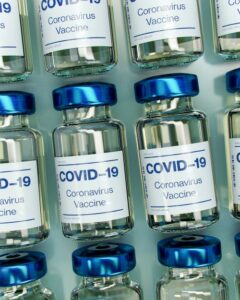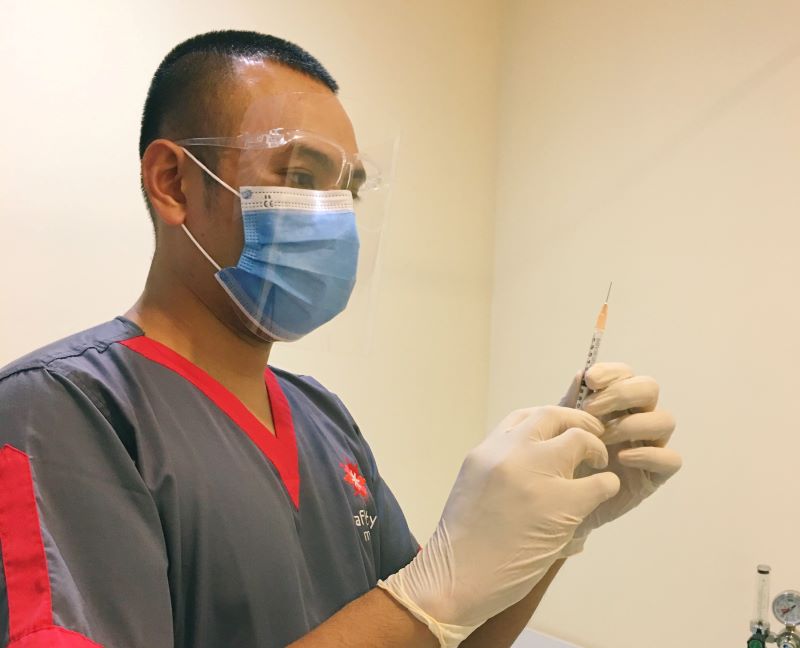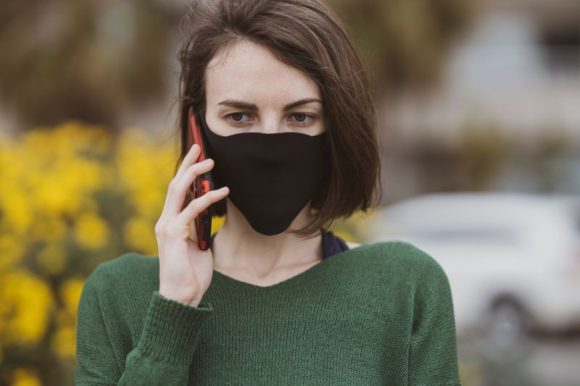Editor’s Note: This is a previously unplanned third of three parts of a highly topical essay titled, “A Primer on Vaccines,” by Thomas D. Gotowka. Part 2.5 reviews Connecticut’s readiness to distribute the vaccine, identifies some of the side effects that may be experienced, and considers the acquisition of individual immunity. Read the previous parts of the essay at these links:
A View from My Porch: A Primer on Vaccines: Part 1; “Still Running to Daylight”
A View from My Porch — A Primer on Vaccines: Part 2; “Approaching Daylight”
When Part 2 of this series was published in mid-December, only the Pfizer vaccine had received emergency use authorization (EUA); the FDA then granted Moderna’s EUA on Dec. 18. As a result, we are now in the earliest stages of a massive vaccination campaign that will span the United States; and millions of Americans will reach the vaccination on-deck circle in 2021.
The COVID “playbook” is still evolving; and guidance will change as the scientific and medical communities discover more about this virus and its reaction to the vaccines. That’s a good thing.
The COVID Data Remain Troubling:
The first autopsy-confirmed COVID-related death in the United States occurred on Feb. 6, 2020 in Santa Clara County, Calif. Just 10 months later, i.e., by year’s end, over 345,000 Americans had been killed by the virus; and, incredibly, we surpassed 20 million cases, with an increase of more than a million cases in the last week of the year.
Unfortunately, this trend will continue through this dark winter; and, by this morning, Jan. 7, we’ve reached nearly 364,000 American fatalities. Finally, COVID hospitalizations are increasing in Connecticut, and may be evidence of another post-holiday spike.
New Vaccines:

Last week, Great Britain became the first country to authorize the use of Astra Zeneca’s COVID-19 vaccine. In addition, a promising vaccine candidate from Johnson & Johnson is proceeding through clinical trials. However, for the foreseeable future, Americans will receive the Pfizer or the Moderna vaccines, both of which require two doses, three or four weeks apart, respectively.
Poorly Executed Federal Vaccine Rollout:
The Centers for Disease Control and Prevention (CDC) has reported that Operation Warp Speed’s promise to vaccinate 20 million Americans by the end of December fell remarkably short of goal; and only about 2.8 million people were provided the vaccine — primarily front-line health care workers, and nursing home residents.
Earlier in December, General Gustave Perna, COO of Operation Warp Speed, apologized for a “planning error” that caused dozens of states to receive substantially fewer vaccine doses than were originally promised.
Predictably, the outgoing Administration then announced that, like testing, vaccine distribution will now be the responsibility of the individual states. Transition to the states occurred rapidly, and with only limited assistance and oversight. There is no plan for logistical support.
They essentially told the states that “this is now your responsibility, figure it out.” Many states will have significant difficulty in meeting this challenge. However, the Coronovirus Relief Bill, which was reluctantly signed into law by the outgoing president at the end of December, includes some financial assistance for the states’ vaccination rollout.
Vaccine Distribution in CT:
Connecticut began preparing for vaccine distribution well before the candidate vaccines were on the threshold of the United States Food and Drug Administration (FDA) emergency use authorization.
Governor Lamont had appointed a broad-based Vaccine Advisory Group, who worked with the state’s Department of Health (CT DPH), the local health departments, CDC, and a group of providers and healthcare institutions to develop a phase-based program, which the Governor presented last October. The Governor also stated, at that time, that the state’s goal was to have everyone in the state “who wants a dose” to be vaccinated by early fall of 2021.
You can review the details of CT’s vaccination plan at Phases (ct.gov) .
At present, Connecticut is vaccinating people who meet Phase 1a eligibility, which includes front-line healthcare workers, and residents and staff of long-term care facilities. CVS Pharmacy teams began to administer the first dose of the Pfizer vaccine in Connecticut skilled nursing facilities on Dec. 21.
By the end of that month, they had administered more than 50,000 vaccine doses. The role of CVS in Connecticut’s vaccination program is reviewed in: A View from My Porch — A Primer on Vaccines: Part 2; “Approaching Daylight” (LymeLine.com)

Phase 1b:
The Governor has confirmed that Connecticut remains on track to complete Phase 1a by the end of January; and the CDC recently reported that Connecticut is ahead of most states in vaccine distribution. Phase 1b is expected to begin immediately after completing Phase 1a objectives, and will probably extend into June.
The Governor’s Vaccine Advisory Group has just recommended that Phase 1b target frontline essential workers, residents of congregate settings and those aged 75 and older. This will include teachers, grocery store workers, police officers, food service workers and sanitation workers.
Congregate settings include homeless shelters, prisons, psychiatric facilities and group homes. The Advisory Group has not yet decided whether this next phase will also include residents, who are under the age of 75, but have underlying health conditions that place them at high-risk of serious illness from COVID-19. It appears that heathy people, ages 65 to 74 years old, may, otherwise, be deferred to Phase 1c.
Side Effects:
The most common side effects for both vaccines include pain and swelling in the arm where you received the injection; fever, chills, fatigue, and headaches, and muscle and joint pain. There was some early concern regarding a few claims of “Bell’s Palsy” following receipt of the Pfizer or Moderna vaccine in the clinical trials. (“Bells” is a condition that causes temporary and mild weakness or paralysis of the facial muscles).
This was not considered significant, however, because the incidence rate of the condition in the clinical trial was very comparable to the incidence of Bell’s Palsy in the general population.
Note that the CDC and FDA are monitoring adverse reactions, using a national data collection system. Healthcare professionals are required to report certain adverse events; and vaccine manufacturers are required to report all adverse events that come to their attention. Vaccine Adverse Event Reporting System (VAERS) (hhs.gov)

Immunity ETA:
As noted above, the Pfizer and Moderna vaccines both require two doses, three or four weeks apart, respectively. Based on the current literature, you will have some protection about 12 days after the first dose.
However, you will not receive the strongest immunity until after the second dose — at least seven days after the second for the Pfizer vaccine; but at least 14 days after the second for the Moderna vaccine. Therefore, it is important that you continue wearing a face mask, practice social distancing until one to two weeks after your second dose.
Questions (Always) Remain:
There is still a need for continuing study. We do not yet know how long vaccines will confer immunity. Although the vaccine may be more than 90 percent effective in blocking the symptoms of COVID-19 at the individual level; it is still unclear whether it will reduce transmission and stop the symptomless spread that accounts for a large portion of cases
Some Final Thoughts:
Vaccinations for the general public are not expected to begin until late-summer but, by then, vaccines will be available in a wide range of healthcare sites: physician’s offices, hospitals, pharmacies, community health centers, and other locations that would normally administer influenza vaccines. Note that Connecticut is not mandating vaccination. So, it’s an extremely important public health program that requires we “rely on the kindness of strangers.”
As I write this, I am distracted by the televised play-by-play of a violent attack on the Capitol by a group of domestic terrorists, which was apparently instigated and applauded by the outgoing Executive Branch.
All that said, I believe that Connecticut is well-prepared to carry out this massive vaccination program. Other states are woefully unprepared. For example, Florida has what appears to be a poorly organized, “first come, first served” program.
We must make certain, however — and especially as other states reach readiness — that the vaccine supply line is continually sufficient to meet immediate requirements.
I’ll close by paraphrasing Queen Elizabeth II: 2020 was without question an “annus horribilis.” Let’s not allow its ‘horrible-ness‘ to spill over any further into 2021.
This is the opinion of Thomas D. Gotowka.

Tom Gotowka
About the author: Tom Gotowka’s entire adult career has been in healthcare. He’ will sit on the Navy side at the Army/Navy football game. He always sit on the crimson side at any Harvard/Yale contest. He enjoys reading historic speeches and considers himself a scholar of the period from FDR through JFK.
A child of AM Radio, he probably knows the lyrics of every rock and roll or folk song published since 1960. He hopes these experiences give readers a sense of what he believes “qualify” him to write this column.